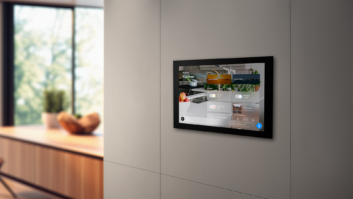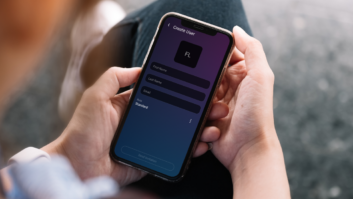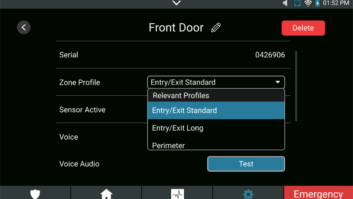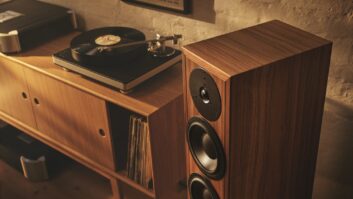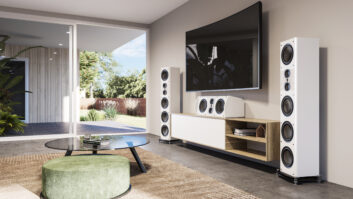For manufacturers, keeping up with technology is as important as keeping up with the Joneses on the home front. And for touchscreen panel suppliers, keeping up with the needs of their customers includes not only technology itself, but also the ease of set-up and programming. With their eyes on all these areas, some of the top suppliers of touchscreen panels are offering new and improved versions of their products to stay on the cutting edge.
The biggest changes in touchscreen panels over the years have been the improvements in graphics quality, said Chris Monck of AMX’s Consultants Support Group. “It is truly consumer driven,” he explained. “The touch panel has gone from including basic graphic images to a high level of graphics that are comparable to a high-end commercial product. Now that consumers are more familiar with GUIs, they want more information added to their touchscreens, such as more detailed control of lighting and the accessibility to stock quotes and other ‘Net-based information,” Monck said.
There is also a move toward smaller touch panels, he noted, but these miniaturized products cannot offer the same graphics quality as larger units. Still, he added, manufacturers are making strides in increasing panel brightness and color depth, in large part due to the success of handheld computers and laptops, which drive chip makers to improve their components. AMX unveiled new panel sizes for its own touchscreens during this year’s InfoComm in Las Vegas.
Getting Smarter
Smart Systems is redesigning its in-wall touch screen to improve the unit both aesthetically and for practical purposes, and they are also adding a feature that the company says will enable homeowners to better manage their energy consumption. Despite these improvements, the cost of Smart System’s touchscreen will remain the same to dealers.
The redesigned Smart Systems touchscreen panel, to be released in late August, includes the addition of a bezel around the screen to give it a more rounded shape. The company has also increased the intensity and improved the resolution of the product by adding a cold cathode for backlighting. With the installer in mind, additional improvements also make it easier to install the unit; Smart Systems’ black box now mounts like a retrofit box that easily clamps onto sheetrock.
The newest feature to Smart Systems’ touchscreen system is Smart EM, which Keith Ostwald, vice president of marketing, said is the “first step toward energy management.” Smart EM enables users to access energy consumption information from the energy meter or submeter at the service panel, directly from the touchscreen. Specifically, it will be able to give kilowatt consumption in real time. Armed with this information, home owners can make adjustments to their energy settings to help conserve energy. The system will allow users to set conservation modes (EM modes) that they will also be able to override. In addition, Smart Systems expects to make available an interface that will enable consumers, in cases of extenuating circumstances, to override power company shut-offs during mandated energy conservation.
Software Strategy
Crestron has focused on redesigning software to help cut down on programming time for systems designers. Essentially, said Doug Jacobson, software designer for Crestron, his company’s new Application Builder software not only makes writing a program easier, but it can write a program for you. Application Builder is similar to the company’s previous Smart Touch software, yet it is more powerful and has an upgrade path, enabling users to edit while in Crestron’s SIMPL Windows or Vision Tools Pro-E software. And, unlike Smart Touch, Application Builder supports all Crestron hardware, including wall-mounted keypads, Jacobson reported.
Crestron is positioning Application Builder for dealers with limited programming expertise, as well as experienced programmers who can use it as a starting point, says Ray Coneys, manager of technical sales. The software works by asking a series of questions, such as, “What device do you want to control; where is it located.” Users simply input their answers, and a program will automatically be generated. While this helps the novice, it also cuts down on time for the advanced programmer, who can then go into SIMPL Logic or Vision Tools and customize the program that was generated.
One of Crestron’s goals in developing Application Builder was to help make the task of programming more automated, and to develop some type of standardization in certain types of programs. It was officially released on June 4.
Coneys estimates that Application Builder can generate a basic program in 20 minutes, shaving off hours of programming time. For example, if a designer was working on a boardroom, it may take up to eight hours to generate a program from scratch, but by using Application Builder, “you could probably do the same system in less than half the time,” Coneys said.
There is also an additional benefit to Application Builder, Jacobson said. “It can really be a nice learning tool, since the dealer can look at how a program was generated, and they can see how a program is supposed to be written.”
The compete Application Builder software will come bundled with some application-specific plug-ins, such as an audio distribution package, while additional plug-ins will be available for purchase separately. These plug-ins are essentially packaged software systems that help write various programs by grouping products intelligently, Jacobson said. “They are really time savers.” At press time, it was not yet determined which plug-ins, other than audio distribution, would be bundled with Application Builder. The software itself is available at no charge.
Improving Integration
Elan’s Via! touchscreen panel is universal IR-based, making it compatible with virtually any IR-equipped product. Originally released last September, Elan is taking the Via! one step further by offering the SC-4 interface, an RS-232 system controller that will enable the touchscreen to integrate and control a variety of RS-232-controlled systems. The one-way serial communications control interface is expected to be available mid-August.
Rick Gratz, product manager, said that, initially, Elan will have prewritten RS-232 protocol libraries available for lighting control manufacturers Lutron, Vantage and LiteTouch on its website (www.elanhomesystems.com). Users will be able to go to a pull-down menu on Elan’s site and assign the protocol for a particular product/product line to any Via! button.
Elan’s newly launched Via! Interface Partner (VIP) program, will enable the company to develop two-way serial interfaces for other charter members, Enerzone, NAPCO, APEX, B&K and Kenwood, by October. In addition, Gratz says that Elan’s customer support will be able to provide help with all products that the installer is trying to interface with the Via! touchscreen.
“We will support every manufacturer that we can interface with by having a fully operational system for each manufacturer set up in our own technical support department,” Gratz explained. This enables technical support to duplicate the situation that the installer is experiencing in the field. The hours for its support department will remain the same: 8 a.m. to 7 p.m. EST, Monday through Friday, and Saturdays, 9 a.m. to 2 p.m.

